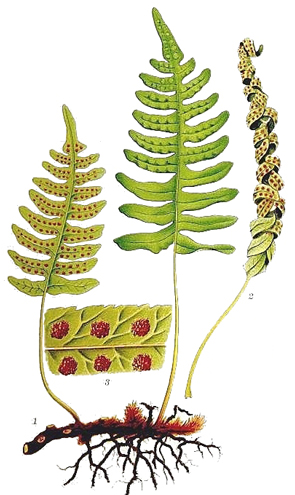| Polypodium | ||
Polypody | ||
|
Etymology
Polypodium is from the Greek: polys, many, + podion, foot. The branching rhizome and its roots appear many-footed. Others think it refers to the many stipe bases on the upper side of the stem.
Description
Rhizome: creeping, branching, scales concolored to bicolored, lanceolate to ovate-acuminate, not clathrate to strongly clathrate.
Frond: evergreen, monomorphic. Stipe: jointed at base, straw-colored, scaly or not, vascular bundles: 3. Blade: pinnatifid, broadly ovate to deltate, leathery. segments linear to oblong, margins entire to serrate, veins free or netted. Sori: circular to oval, discrete, borne at tips of single veins, in 1-3 rows on either side of midrib, often confined to distal region of leaf, indusium: absent, sporangia: transparent or yellowish.
Distinctive Characteristics
pinnatifid, leathery blade, long-creeping rhizome, fronds jointed to the rhizome, and the naked sori.
Compare species in the Eastern Asia Group
Compare species in the Eastern North America Group
Compare species in the Western North America Group
Compare species in the European Group
|
|
|
Notes
Variability All the species here are highly variable in frond size, frond shape, and sorus positioning. More than most ferns, polypoids respond to diminished resources with diminished dimensions. And they overlap in many characters.
Variability All the species here are highly variable in frond size, frond shape, and sorus positioning. More than most ferns, polypoids respond to diminished resources with diminished dimensions. And they overlap in many characters.
